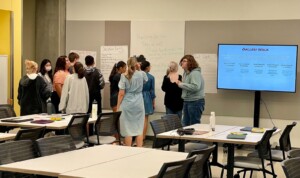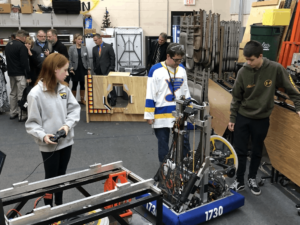Leadership Implications of the Brave New Blended World

Everything is changing…
- Mobile devices and apps; adaptive instruction–teachers, parents, and kids flipping and blending their own learning.
- Online learning and new tools are being blended into new school models that leverage great teaching with technology.
- And just beginning to emerge: learner profiles, smart playlists, customized and competency-based pathways.
Everything is changing…except for a bunch of stuff that isn’t…
- Great teaching matters…a lot.
- Great schools have safe supportive environments.
- Educators (and parents) can be risk averse.
Everything is changing…except for a bunch of stuff that isn’t…so what does it mean for EdLeaders?
- EdLeaders need to balance execution and innovation:
- Execution: managing repeatable processes that deliver solid instruction in every class every day (e.g., Doug Lemov’s Teach Like A Champ)
- Innovation: new tools/approaches seeking step function improvement (e.g, Clayton Christensen’s Disruptive Innovation)
- EdLeaders need to be design thinkers open to new approaches; IDEO’s Tim Brown suggeststhat takes insight, observation, and empathy;
- EdLeaders are conversation leaders building intimacy, interactivity, inclusion, and intentionality; and
- EdLeaders need to be policy advocates for local and state policies that extend opportunity and equity.
If EdLeaders need to be some mixture of Doug Lemov and Clayton Christensen while effectively communicating and advocating, what are the implications for preparation?
1. Process management: APQC calls it “a leadership approach that promotes effectiveness and efficiency by linking process measures to outcomes.” Process leadership combines process analysis, process improvement, and coaching to boost fidelity to best practices. The best way to learn these skills is to serve as an instructional coach while learning technical process management skills (via courseware with a cohort or accessed on-demand).
In some networks/districts instructional leadership is the principal’s primary role and the curriculum and pedagogy are model specific requiring extensive model-specific preparation (see recent feature on Success Academy).
2. Design thinking: While process management is process-centric, design thinking is student centered. It’s starts with desired outcomes and is open to a variety of solutions. IDEO‘s Sandy Speicher said design thinking “means to connect with the lives of students.” Because design thinking relies on borrowing innovations from other fields, a stint in consulting can be very useful. In addition to problem analysis and presentation skills, consulting provides preparation in group problem solving, ideation, design, and planning.
Design thinking is most useful for principals leading their school through development or adaptation of a blended learning model. Read how Katie Decker used blended improvement strategies at Bracken STEAM in Vegas.
David Haglund, Riverside Unified, said field trips and benchmarking best practices inside as well as outside of education have promoted design thinking and helped principals see new possibilities.
3. Community building: Good education leaders are great listeners, conversation leaders, community organizers, and campaign leaders. They need to be well verse in political psychology, campaign strategy, communications, and social media. Leading community service projects and campaigns can be invaluable experiences for aspiring educational leaders. Learning to cultivate a positive social media presence is a must. Marketing to parents is important in portfolio districts.
Read how New Milford High School Principal Eric Sheninger (@NMHS_Principal) helped connect his community with social media.
4. Personal effectiveness: Education leadership is incredibly demanding. It requires strong planning skills, sound judgement, effective communication, and empathy. The ability to take feedback and use it to improve is critical. Reading and coursework can be useful, but practice under the tutelage of a mentor or coach is often best.
New Leaders created the Urban Excellence Framework which has “personal leadership” as its foundation (page 63). It includes: Belief-Based, Goal-Driven Leadership, Culturally Competent Leadership, Interpersonal Leadership, Adaptive Leadership, and Resilient Leadership. Principals must “strike a balance between being very firm about non-negotiables…and demonstrating genuine engagement with other, humility, and relationship-building.”
Traditional preparation programs are pretty thin in the development of these skills and dispositions. While they may cover a lot of important content, don’t typically don’t include broadening experiences–and most districts aren’t doing enough to fill the gaps.
It may be unrealistic to think we can create an army of leaders that can flex from Lemov to Christensen, explain like Clinton and campaign like Axelrod. Specialization and model-specific development pathways are part of the answer.
As the number of blended models proliferates, teaching and leadership roles are beginning to vary considerably from model to model. As a result, it will become increasingly important to make a large percentage of teacher and leader preparation model specific. Anywhere anytime personalized learning tools and strategies can make this efficient with a combination of scheduled experiences and on-demand learning.
Helping teacher leaders come to understand their gifts is the first step in developing a specialty. Some leaders are great coaches and should focus on instructional leadership in a district or network where that is valued and supported. Great conceptual thinkers are good in startup mode but the daily grind of leading a school doesn’t suit them. Other leaders thrive on the turnaround challenge. The dynamic blended future of education will allow more role specialization.
In addition to increased specialization, another factor that will help is teacher leadership. As the adoption of blended learning extends the opportunity culture, most schools will adopt staffing strategies that leverage great teaching with technology and will create more leadership roles for effective educators–more team-based teaching and team-based leadership.
Confused at a higher level? Here are a couple specific suggestions for improving the quality and effectiveness of principal preparation:
- As Digital Learning Now! suggests certification should be performance based. Schools, districts, and networks should have the ability to work with any organization they choose to craft leadership development pathways. School leaders should earn reciprocal certification based on demonstrated performance.
- Districts (and networks) should refuse to hire leaders that come out of inadequate preparation programs. Working with other districts, they should demand preparation partnerships aligned with something like the Urban Excellence Framework.
- Like military leadership development, districts/networks should identify promising talent, provide broadening experiences, on-the-job training, and more candid feedback.
- Like Leadership Public Schools, districts can distribute innovation projects among schools giving a large number of teacher leaders valuable project-based collaborative leadership experiences.
- Like learning experiences for entrepreneurs at General Assembly, high quality on-the-job training (online and blended) should be available from experts and with talented peers.
It’s time to rethink leadership preparation in education. The old university model is obsolete, expensive, and time consuming. It’s time for new pathways and new partnerships that prepare leaders for the schools our children deserve.
Digital Learning Now! is a Getting Smart Advocacy Partner.






Jeff Underhill
Tom, thank you for your thoughts and their depth! With the discussion of blended learning, it comes down to, "Where are we going?" Education today is in dire need of the leadership you argue for; leaders who flex, communicate, and get the new opportunities in education present through technology and more. I agree: Leaders need to fit the model they lead, with a world of so many models. (I'm an international educator, plan to continue as such and into leadership, and in the international community there is incredible diversity in education models.) The resounding question is, "Why are systems not developing the leaders they so need?" Do leaders view teachers as the leaders they are each day? Overlaying your insights into leadership with insights I have as a teacher currently in the classroom, I notice both matches and differences in what's required in terms of leadership ability. Are teachers demanded upon enough in terms of leadership through peer collaboration? I would argue, no. Such opportunity would open new insights for teachers into what is needed to lead the wider community. Students teaching students is continually argued for, and rightly so. Will we begin to argue for teachers teaching teachers? This must be the focus of leaders: Leaders who foster leadership.
Jeff Underhill
Education today is in dire need of the leadership you argue for; leaders who flex, communicate, and get the new opportunities in education present through technology. I agree: With a world of so many models, leaders need to fit the model in which they lead. (I'm an international educator, plan to continue as such and into leadership, and in the international community there is an incredible diversity in education models.) The resounding question is: "Why are systems not developing the leaders they so need?" Do leaders view teachers as the leaders they are each day? Overlaying your insights into leadership with personal insights into being a teacher currently in the classroom, I notice matches and differences in what's being called for. I would argue it would be beneficial to have teachers with the qualities you argue for in leaders, that teachers would see themselves as leaders to a much greater degree. Students teaching students is best practice. Will we begin to call for - nay, to demand - teachers teach teachers? This must be the focus of leaders: Leaders who foster leadership.